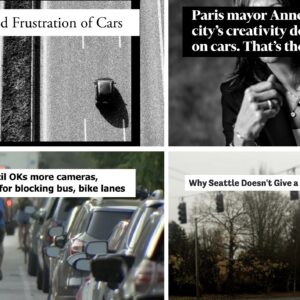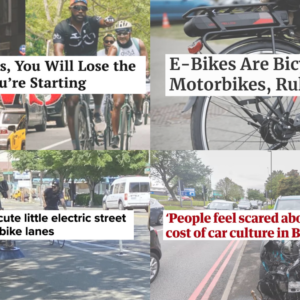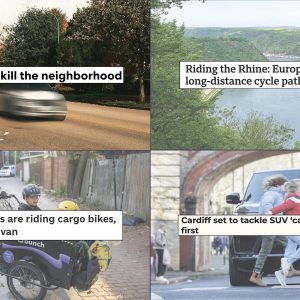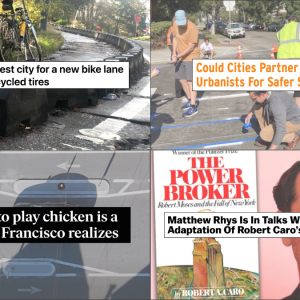This week’s Monday Roundup is sponsored by Laughing Planet, where you can now get food delivered by bike in downtown Portland.
Here are the bike-related links from around the world that caught our eyes this week:
Better lock? The Litelok markets itself on its 2.2-pound weight, but the bigger feature might actually be flexibility. Here’s the $120 product’s promising Kickstarter.
Car-free retail: A narrow cobblestone street in Rome closed to cars and opened to walking during a construction project, but may never go back, because retail sales jumped 30 percent.
Sticks and carrots: Paying employees to bike to work won’t change any habits if you’re simultaneously paying them to drive by offering free parking.
Designing for revenue? Build your city with lots of 25-foot-wide streets.
Quick commutes: Portland’s are faster, on average, than most large cities’.
Protected lanes: Minneapolis will spend $790,000 to build 5.6 miles of protected bike lanes around its central city this year. The projects will likely use plastic flexposts, a low-cost separation method that’s become popular around the country but never yet been used in Portland.
Must-click headlines: Washington, like Oregon, has a bill in its legislature that would allow people on bikes to proceed carefully through stoplights whose sensors are failing to detect them. But for some odd reason, even news articles that clearly explain this concept at the start of the story fail to capture it in the headline.
Vision Zero: “It’s time to slow down to the speed of life,” writes Seattle Transportation Director Scott Kubly in a Seattle Times op-ed explaining his city’s new policy.
Theft investigation: A Twitter tip to @SeattlePD led the city’s Major Crimes Taskforce to investigate a man selling high-end bikes at deep discounts. That led to a sting, an arrest and 27 recovered bikes.
Cyclists Party: That’s the official affiliation of one Australian publisher turned politician.
Advertisement
Schwarzenegger detained: The former California governor was pulled over in Melbourne for a traffic violation: riding a bike share bike without a helmet.
Expired concept: A bike frame made to resemble a naked woman is just an “idea that was avant-garde (and kind of shitty) more than fifty years ago,” writes Camille Perreault.
Free kids: Here’s a German dad’s perspective on American parenting and the “narrowing of the child’s world.”
Share the cage: Cartoonist Bikeyface imagines zoos designed by anti-infrastructure biking advocates. “Can someone please get the zebra a reflective vest and a copy of my book?”
Incitement outrage: A California meat purveyor who wrote on his blog that people who bike in traffic lanes are “fair game” seems surprised at the online whirlwind he reaped.
Helmet mandate: In California, a proposed mandatory helmet law makes as much sense as one that would “require pedestrians to wear body armor,” the Los Angeles Times editorializes.
Foxx’s fears: To write this news item about the U.S. transportation secretary, the staff of The Onion seems to have started with the photo and worked backwards.
Downtown jobs: Portland economist Joe Cortright talks to Streetsblog’s podcast about the shift of jobs to urban cores.
And finally, your video of the week is a pretty good 90-second summary of a modern bicycling advocacy agenda:
If you come across a noteworthy bicycle story, send it in via email, Tweet @bikeportland, or whatever else and we’ll consider adding it to next Monday’s roundup.







Thanks for reading.
BikePortland has served this community with independent community journalism since 2005. We rely on subscriptions from readers like you to survive. Your financial support is vital in keeping this valuable resource alive and well.
Please subscribe today to strengthen and expand our work.
Someone send Sarah Holliday that piece about carfree retail in Rome. And Roger Geller, too.
This Grist question reminded me of all y’all. Best bike frames for the environment: http://grist.org/living/what-is-the-greenest-type-of-bike-frame/
and Umbra’s conclusion was… buy used! Where have we heard that before?
Thanks for that, Erin. Good link in there as well (click on “shatter”) to a NY Times article on frame materials.
I read the NYTimes story on free range kids. If you’re going to encourage people to gamble, I suppose for some people, there’s nothing like encouraging them to gamble with human lives. The writer doesn’t tell much of anything about the town or neighborhood he’s moved to, though the opening words to his story are ‘BETHESDA, Md.’.
Telling a bit about what kind of setting he’s allowing his child to run free in, would help give a better sense of his judgment. At any rate, his story goes, that his 8yr old child just up and leaves the house, without even telling the parents where she’s going, and for how long.
There seems to be plenty of places where that sort of thing just doesn’t make good sense at all, regardless of whether rates of incidence indicate chances of a child being abducted is low.
I think you’re missing the author’s/dad’s point, wsbob.
Your, and others’ ‘it just doesn’t make sense’ is a socially constructed, and apparently statistically invalid, judgment. Did you read the part about the statistical incidence of child injury and death while sitting in a car? Almost made me wonder if the author was El Biciclero, who has made that comparison quite evocatively here a few times if I am remembering correctly.
9watts, I get the author’s point. I, and I think many, many people with good reason, just don’t think his point is a good one. His point is simple rationalization of behavior that’s a potentially serious risk for many people and their kids, depending on their personal situation which very possibly is not the same as the author’s.
The author Clemens Wergins, unfortunately in his effort to claim superiority of the ‘free range parenting’ idea above what he regards to be an inferior manner of supervising kids in the U.S., doesn’t talk about how other people’s situation may differ from his. And how that could be a factor in the advisability of using the ‘free range parenting’ ideal.
A number of people responding to the subject I brought out in this comment section, cite hazards to kids crossing the street, presented by people that drive badly. That type hazard, is in fact one example of reasons that ‘free range parenting’ may not be a good idea for many people.
“don’t think his point is a good one”
Well he does have statistics on his side. What would you offer up to counterbalance those?
Would you agree that, right now, those who we might call close-range parents, who keep their kids tightly buckled in the back seat so as to protect them from the vagaries of the dangerous world, are in fact unwittingly exposing several thousand of them to death—every year? Meanwhile those, like Mr. Wergins, who take a rather different approach, though they may be going against the grain, nevertheless seem to have statistics on their side.
I think the specter of death-by-unsupervised-exploration, which has very little basis in fact, is preventing you from recognizing that by just about any measure we’d care to use the free range approach involves fewer actual bodily risks (never mind the innumerable well-understood benefits, both to the individual and to society) than the close range approach you seem to, implicitly, favor.
“Well he does have statistics on his side. …” watts
Which don’t count for much when a kid is injured, killed or gone due to lack of sufficient parental supervision. Especially when someone has unwittingly accepted bought the idea of ‘free parenting’ without being aware of hazards associated with it.
wsbob,
what you are saying makes exactly no sense.
“Which don’t count for much when a kid is injured, killed or gone due to lack of sufficient parental supervision. Especially when someone has unwittingly accepted bought the idea of ‘free parenting’ without being aware of hazards associated with it.”
You can’t seem to allow that close range parenting is—at least if Mr. Wergin’s statistics are to be believed and I have no reason to doubt them—associated with a greater probability of hazard (death is a pretty unambiguous hazard) than free range parenting, which you enjoy casting aspersions on here. By your logic, then, close range parents have *wittingly* accepted the hazards of ferrying their issue around in the back of their SUVs, since the statistics that show how dangerous that is are well known. How do you explain that behavior?
If you want those of us who appreciate what statistics can tell us to take your point of view seriously you are going to have to do better than wave your hands at the discrepancy Mr. Wergins noted in his article.
One more thought.
If I am not mistaken, both the free range approach and the close range approach ‘enjoy’ positive feedback, a collective windfall: the more parents let their kids roam, the safer it becomes for those kids, not to mention the rest of us. But the more parents switch to driving, buy bigger vehicles, and buckle up their kids in the back seats, the more injuries and deaths are experienced by those kids. Or am I missing something?
“wsbob,
what you are saying makes exactly no sense. …” watts
What I’m saying makes plenty of sense to me, and to many, many other people who look more deeply into the reality of the ‘free range parenting’, free range child idea than Wergins does in the NYTimes article. Wergins could have, but doesn’t in his article, cover any of the considerations a responsible parent would logically make before allowing themselves and their children to use the ‘free range’ idea. I touched on this in an earlier comment.
Wergins paints a rose colored glasses view of the ‘free range’ idea, to seemingly say, ‘We in Germany, know better than you Americans, how to allow our kids to develop.’. Wergins’ article leaves me questioning how responsible a parent he is. What he writes, definitely raises doubts as to whether he should be advising other parents to let their kids go out of the house beyond the yard without letting the parents know where they’re going, and for how long.
First, let me say that the story to which the NYT article refers makes me very, very angry.
Why would there be anything to cover if a responsible parent would “logically” make appropriate considerations in the first place? Tell me you don’t think a “responsible” parent would just send their kids off into inappropriate situations unsupervised because they overheard some dude on the bus talking about this Free Range thing he read about in the New York Times. Further, does the State of Maryland really, really believe that putting a 10- and 6-year-old into foster care would be less detrimental to their well-being than allowing them to walk a mile unsupervised? I cannot express in words the depth of the affront to family autonomy and dignity this thinking represents.
And to the point 9watts and Wergins himself make, what “logical considerations” does a “responsible” parent need to make before strapping their kids into a car? Statistically speaking, “responsible” parents would let their kids walk to school alone before they would drive them there, since driving them is so much more dangerous. The cognitive dissonance of this notion of “responsible” is almost laughably unbelievable. This is irrational, fear-based authoritarianism at its near-worst.
And, you’ll be dismayed to find out that the situation that caused so much uproar in Maryland would not have been expressly illegal here in Oregon.
Exactly. Places like Beaverton, where other people driving their kids around in cars at high rates of speed present a safety hazard for all of the other children.
Yes this is especially true in school zones by the very parents dropping their children off/ picking up…this was often my findings, in my many visits to school zones for traffic safety assessments. The best thing school districts can do other than locating in an older walkable neighbourhood is to have driving parents park away from school zones and wait for their “children as passengers” to be released AFTER the walking and cycling students have had time to disperse (or arrive) off campus.
I’m always amazed at how dangerous I find drivers are behaving around September every year, only to remember that it’s because school is in session again after having a summer reprieve.
And not just elementary schools… I rode down the Ankeny greenway this morning on my way to the office and was puzzled by the complete lack of insanely hurried cut-through traffic. Then I realised it’s spring break, and Central Catholic HS is not in session.
“Yes this is especially true in school zones by the very parents dropping their children off/ picking up…” Todd Boulanger
Exclusively occurring in “…Places like Beaverton, …” (whatever it is he’s implying.) as Chris I suggests? I doubt it. What I’ve noticed, is that people drive about the same in Beaverton, as they do in Portland.
How people drive though, is not the subject of the NYTimes ‘free range parenting’, or free range kids story.
Snark. Chris, I would have thought you could set aside your petty animosity and offer something more sensitive and thoughtful to the subject. Groundlessly slamming Beaverton, most likely because you want to lob a mean insult at me, doesn’t give much depth to the subject that Clemens Wergins, writing for the NYTimes brings up.
The idea of allowing children autonomy to evaluate and decide what’s best and safe for them, has merit. It’s not a new idea. In fact, for parents, allowing their children to gradually take on greater measures of responsibility for themselves, is a fundamental part of raising kids.
The problem with the pitch of Wergins’ story, is that it doesn’t include any of the subtleties of parental judgement associated with allowing kids to safely have the free range he writes about.
As statistics Wergin cites in his story, confirm, kids do occasionally get snatched. They get run over by road traffic, for a variety of reasons, and not simply because people drive to fast or don’t follow rules of the road. There are enough problems already with parents insufficiently supervising their kids, without people adding fuel to the fire.
“As statistics Wergin cites in his story, confirm, kids do occasionally get snatched. They get run over by road traffic, for a variety of reasons, and not simply because people drive to fast or don’t follow rules of the road. ”
I think you misread that statistic quoted in the NYT article, wsbob. I’ve highlighted the key phrase for you below:
“That same year, 2,931 children under 15 died as passengers in car accidents.”
Pretty sure the number of kids that get snatched is a little more than 100 a year.Since crime rates have been steadily declining for over a decade now, kids walking and playing in the neighborhood is safer now than ever. Of course this is completely irrelevant since most here seem to think that riding a bike is dangerous – which it is not in the least.
Instant news access is what makes everything (including riding a bike) seem much more dangerous than it really it.
Though I have noticed there is a huge increase in the number of helicopter parents out there who often seem crazier when it comes to their children than the crazies on the street.
Glad I never had to deal with this, been sending my kids to school playground four blocks away unattend since they were 6 or 7, was even letting them ride their bikes and scooters in the street at around the same time. They’re too old to get me into trouble now.
by the way that little over 100 children snached by strangers every year is in comparison of 41,705,000 students enrolled in nursery school to middle school in 2013 (according to the US Census).
Kid snatches, or attempts, happen in the Portland area, and not infrequently. Casual browsing of the Oregonian reveals this. Of course, for people content to rationalize away, based on statistical counts, the danger of child snatching, such warnings will be of little value.
Everybody does a bit of rationalizing danger in their day to day life. So it comes to questions of the relative degree of that danger. Use of the street by someone riding a bike, is far more dangerous than use of the street is by someone driving. This is so, because the person riding on the street, is exposed to the power and force of motor vehicles, without the protective features that motor vehicles offer their driver and occupants.
Similarly with kids on their own, unattended by responsible adults, they’re vulnerable to bigger, more powerful and forceful adults with bad intentions.
But riding a bike on the street isn’t more dangerous.
Please remember that roughly half of all bicycle injuries don’t involve a motor vehicle, and a significant number of bicycle deaths don’t either.
Oh yes, the “kid snatches” that everyone is so afraid of. Never mind that non-family abductions are a tiny portion of the total abductions, and as stated above, number roughly 100 per year in this country. Compare that to the approximately 1300 children ages 2-14 killed as passengers in vehicles each year.
The way that you dismiss statistics in favor of a few stories in the Oregonian pretty much summarizes how most people make decisions. The fact is humans are very bad at making decisions about things that have extremely low probabilities and terrible consequences.
“Use of the street by someone riding a bike, is far more dangerous than use of the street is by someone driving.”
To whom?
Also, kids—both supervised and unsupervised—get injured and killed by cars, either while riding in them or walking or riding bikes in their vicinity. Just using this one point of comparison, it is still much safer to allow your child to walk unsupervised (as long as you are reasonably certain they understand how to watch for traffic—I certainly wouldn’t send my four-year-old to walk to the store by himself) than to drive them to their destination. There are some statistics by the IIHS that reveal an interesting trend: while deaths of children under 13 as passengers in cars have decreased 60% since 1975, deaths of children as pedestrians and bicycle riders have decreased by about 90% in that same time. This would appear to indicate that either fear has driven most children into cars, or that while it is safer to ride around in a car nowadays, it is much, much safer to walk or ride bikes places than it was when I was a kid.
It would also appear that being injured while riding in a car, or being injured by a car while walking or riding a bike are both much more likely than being kidnapped by a stranger.
So we would seem to have a ranking of risk level from greatest risk to least risk that looks like this:
1. Riding in a car
2. Being hit by a car while walking (supervised or not)
3. Being hit by a car while riding a bike (supervised or not)
4. Being kidnapped by a stranger while walking alone.
Yet society’s risk assessment profile puts these in just about exactly reverse order. The law seemingly punishes parents for taking a healthier and less risky approach to raising their children while practically requiring them to subject their children to the most risky activity of all—riding in a car. This makes sense?
Thanks for weighing in here, El Biciclero.
I wonder what Taz Loomans might say about this screwy bias, this ascendant cultural antipathy to allowing certain demographics to (continue) using the bicycle or the foot. How did the automobile come to stand for responsibility, and responsibility stand for child safety (and in defiance of statistics that show it to be quite otherwise)?
Peter Norton could probably help too.
I’ve been trying out the # 35 to work recently instead of the Yellow line. It’s shocking, the number of cars that come blasting up N. Willis, blatantly exceeding the 20mph posted school hour speed signs.
The most common culprit appears to be women with school age passengers.
That bike lock looks very promising. Looking forward to some videos of thieves thinking it’s their lucky day only to find out their bolt cutters aren’t going to do the trick.
I’d like to see and independent reviewer hacking at the material. The guy in the demo video was not applying very much force to the industrial bolt cutters. If it’s as legit as they say, I’d certainly love an option like this – particularly for the double-up options.
The ultimate price is going to be pretty high though based on the Kickstarter rewards packages.
I remember being impressed with the TiGR lock when it was on Kickstarter. Apparently their lower end model was rather easily snipped with cutters. So far, I’ve only seen one of these out in the wild – I was tempted to wait around to ask the owner how they liked it. https://tigrlock.com/product/
This newer product seems much more flexible – both literally and in application – in being able to lock your bike to many different anchors.
yeah you gotta press harder to get through a cheap cable. Also notice in the video (50 seconds mark) the blades were chipped, so I doubt they were very sharp.
I’m looking forward to this too: https://www.kickstarter.com/projects/fuzdesigns/noke-u-lock-worlds-smartest-u-lock?ref=hero_thanks
One less key to carry around. 🙂
Regarding the KickStarter lock…nice look and good luck. It is very sweet that 2 locks can be joined…I do this with our AXA link locks too.
We will see if the Netherlands certifies it for secure cycle parking [ART2].
(I would be interested if LiteLock has tried to assault it with freezing or fire methods.)
My recommendation for anyone supporting efforts on Kickstarter is to double or triple the promised time to shipping. (Just to reduce the frustration as there is a lot to do to make a great product commercial especially in international markets.)
Or how about a good old fashioned utility knife? I seem to recall that police bulletproof vests aren’t very good at stopping knife attacks, for instance.
Regarding that Seattle piece on proceeding through red lights bill:
Regardless of the headline, I’m amazed at how wrong commenters always are.
“Bikes are supposed to follow the same laws as cars.” No, no they don’t. They must follow most of the same rules, but just about every state has separate laws on the books just for bikes.
“So we should allow cars to do this too, right?” Well, no. Because bicycles do not have the potential to easily kill a pedestrian or other vehicle operator.
“So if a cyclist gets hit doing this by a car coming through the other way, then is the driver at fault?” Nope. Because the bicycle operator wouldn’t have properly assessed that it was safe to proceed when it was safe to do so.
“So we’re just going to legalize them blowing the lights.” No, see earlier comment. It never ceases to amaze me how people interpret this as “blowing” the lights.
12 paragraphs to get to the actual rules of the law… of course since all the paragraphs prior use the term “run” the commenters are assuming the law allows running a light…
headlines are about revenue, not news…
PS: Washington already has this law on the books allowing for motorcycle riders to do this. They’re just expanding the law to allow bicycle riders to do it. So it’s even more baffling the bike hate in the comments there.
Oregon currently allows for neither but is being proposed.
It amazes me that people continue to be amazed by provocative headlines in the media. These misleading headlines are purposely constructed to draw people into the article and get them all riled up.
Oh, I’m not amazed by the click-bait headline. But I was only disheartened that in 20 comments that were there when I read it, not one demonstrated that they understood anything about the application of the law or the realities of riding a bicycle. Then again, maybe I shouldn’t be surprised – I certainly wasn’t willing to step into he jaws of that rage storm and calmly try to explain it to them.
“So we should allow cars to do this too, right?”
Yes, absolutely. If you can place a car at a stop light and actually see the other lights and count a full cycle where you’re not detected, why not? The reality is it won’t happen, mainly because of all the costs that have poured into detector loops and video cameras and timed signals, etc.
On the other hand if you cross two lanes based on gaps in traffic to take a left with (car) traffic and the light turns red because you didn’t make it, and you’re left sitting at a light that won’t change, is your best option to proceed across the two busy lanes behind you or the two lanes you can see? In my experience it’s been the latter.
For people who don’t want this bill to pass, I’d propose an alternative: make all cities responsible for detecting bicyclists at all intersections (at the significant cost associated with that), and add additional delays to the yellow cycle that can be as short as 3 seconds in order to allow following cyclists time to go through the intersection.
I suspect neither option would be popular.
Improvements in technology that will allow signals to consistently see people waiting at lights, is what I’d advise. The Oregon bill seems like a ‘make-do’ approach. In situations where there is virtually no motor vehicle traffic on roads where someone on a bike is waiting for a light to change, it’s probably not going to be a problem if the person riding rolls through the light after the signal fails to acknowledge them and give them the green.
If on the other hand, there is motor vehicle traffic, and the person riding elects to proceed against a light as the bill proposes, that could turn out to be a very unpleasant surprise for someone.
The bill makes legitimate what is often the safest option for a bicyclist and especially a motorcyclist to get out of the rare situation where the other options may be more dangerous. If the person proceeds against a light without waiting for the full cycle to determine that they haven’t triggered the signal, they are violating the law. There are several left turn lanes I can point to here that simply don’t register a bicyclist (and probably don’t do so well with motorcycles) but after repeated complaints over may years have not been addressed. The worst part is you don’t know this until you’ve already crossed two lanes of traffic – then is it safer to cross the traffic behind you or the traffic you can see?
I believe this law would raise the priority to address defective signalling mechanisms where they exist, because there may be just as much risk to waiting around for technology to catch up and then prioritizing funding without something like this to ‘start the conversation.’
The reality is that most signalling situations work, and the probability of one even needing to utilize this law is embellished by both the article and the comments.
“…I believe this law would raise the priority to address defective signalling mechanisms where they exist, because there may be just as much risk to waiting around for technology to catch up and then prioritizing funding without something like this to ‘start the conversation.’ …” Pete
Definitely a bit of ‘Catch-22’ at play. I’d like to think the law would motivate increased efforts to improve signal technology to the point it consistently recognizes people on bikes, but I don’t know that there’s a reason it would. Short of collisions brought about in part by some poor guy on a bike stuck out in the middle of some busy intersection, tired after waiting through a couple light cycles, and who then decides to make a break for it across traffic.
I wonder if traffic signaling design could have incorporated into it, some kind of recognition confirmation display. Something that would confirm to a person waiting on a bike or motorcycle, that their presence has been recognized by the signal. Distantly related example, is the advance in crosswalk signal technology that among other things offers the time countdown.
One of the worst things when biking, is waiting for the light to change out in the middle of some of the busy intersections, not knowing for certain whether the signal even knows the person on the bike is even there. Some cycles are two to three minutes long, so just two cycles could be up to six minutes, not infrequently exposed to lots of swiftly moving motor vehicle traffic.
There are newer traffic signals that have a small blue light that comes on when the signal gets registered. I’d like them everywhere, yesterday, but then again they still don’t solve the problem of what to do when the signal never gets registered.
The Australian guy running on the bike party ticket. I don’t know why we don’t have a party like this yet in PDX. It’s a fabulous idea.